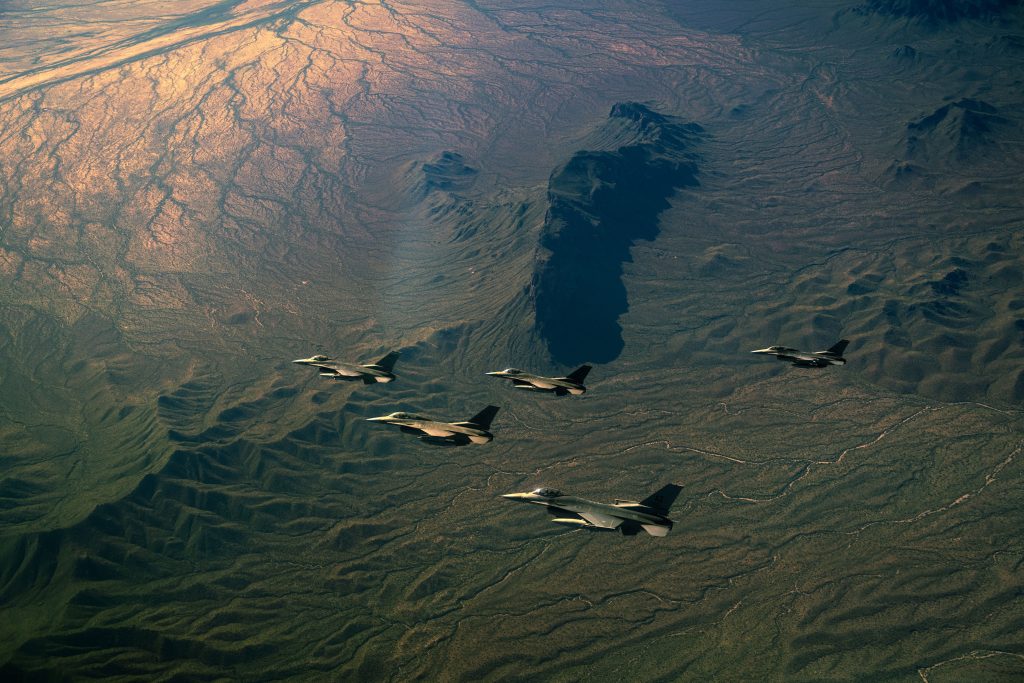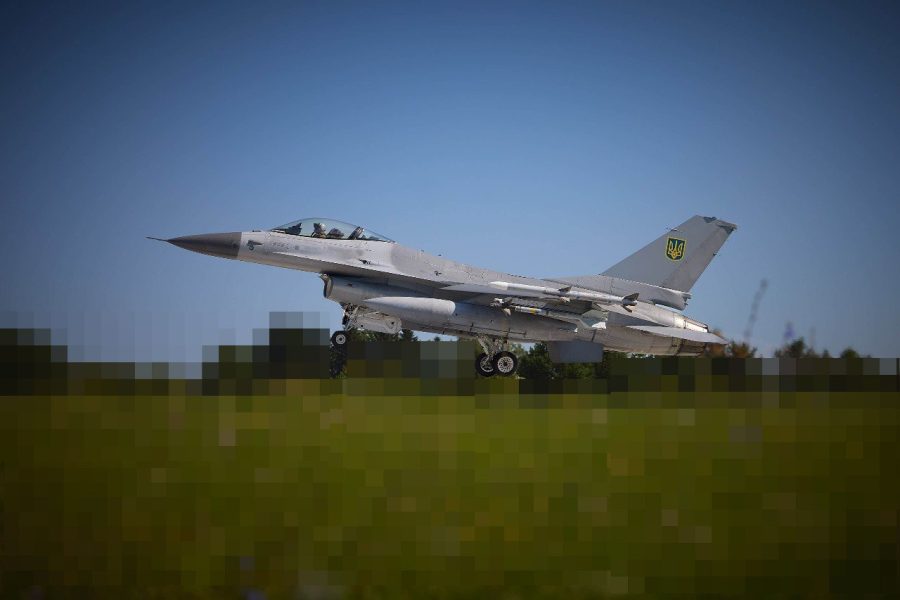The United States will train 18 additional Ukrainian F-16 pilots and provide Kyiv with fresh standoff air-to-ground weapons as part of an $8 billion military aid package, President Joe Biden’s administration announced Sept. 26.
The move, made ahead of a meeting at the White House between Biden and Ukrainian President Volodymyr Zelenskyy, comes as Ukraine has pushed for more Western assistance to fight off Russia’s invasion.
“To build the capacity of Ukraine’s air force, I have directed the Department of Defense to expand training for Ukrainian F-16 pilots, including by supporting the training of an additional 18 pilots next year,” Biden said in a statement.
Zelenskyy presented Biden with a so-called victory plan ahead of U.S. elections in November. He has pushed for the U.S. to allow its weapons to be used to strike targets in Russia that Ukrainian officials say are being used to launch attacks against Ukraine, including airfields. The U.S. has yet to grant that request, and some U.S. officials argue Russia has already moved its aircraft out of the range of U.S. ATACMS surface-to-surface missiles.
But the U.S. will provide Ukraine with AGM-154 Joint Standoff Weapons (JSOW), a medium-range, air-to-ground, precision-guided glide bomb with a range of up to 70-plus miles, the White House announced Sept. 26.
The U.S. has already provided the Ukrainian Air Force with JDAM Extended Range guided bombs—which have a range of roughly 50 miles—as well as Small Diameter Bombs and HARM anti-radiation missiles. The Biden administration has stopped short of providing AGM-158 JASSM long-range standoff missiles, which have a range of upwards of 200 miles, a move it has been reportedly considering.
“For nearly three years, the United States has rallied the world to stand with the people of Ukraine as they defend their freedom from Russian aggression, and it has been a top priority of my administration to provide Ukraine with the support it needs to prevail,” Biden said. “In that time, Ukraine has won the battle of Kyiv, reclaimed more than half the territory that Russia seized at the start of the war, and safeguarded its sovereignty and independence. But there is more work to do. That is why, today, I am announcing a surge in security assistance for Ukraine and a series of additional actions to help Ukraine win this war.”
The JSOWs will provide the Ukrainian Air Force with a new standoff weapon, allowing them to strike ground targets from further away. Neither Russia nor Ukraine has air superiority, and both sides have formidable and ample surface-to-air missile systems. However, the JSOW’s range is longest at higher altitudes and Ukrainian aircraft have had to fly low to avoid Russian surface-to-air missiles.
Ukraine has shot down over 100 Russian aircraft, and Russia has shot down over 75 Ukrainian aircraft, Gen. James B. Hecker, the commander of U.S. Air Forces in Europe and NATO Allied Air Command, told reporters Sept. 17 at AFA’s Air, Space & Cyber Conference.
“Aircraft are kind of staying on their own side of the line, if you will,” Hecker said.
The U.S. is also providing Ukraine with an additional Patriot air defense system as Russia continues its aerial attacks with drones, glide bombs, and cruise and ballistic missiles. Iran recently provided Russia with short-range ballistic missiles, increasing the threat to Ukraine’s energy infrastructure ahead of winter, according to U.S. officials.
“These are deliberate Russian attacks on our power plants, and the entire energy grid,” Zelenskyy said in a speech to the UN General Assembly on Sept. 25.
Some $2.4 billion of the aid announced Sept. 26 will go towards purchasing additional air defense, drones, and air-to-ground munitions, the White House said.
Ukraine has been promised at least 80 used F-16s from Denmark, the Netherlands, Norway, and Belgium. The U.S. is not providing any aircraft but had to give permission for the American-made fighters to be transferred and is helping arm the Vipers with air-to-surface munitions and air-to-air missiles, including the stalwart AIM-120 AMRAAM.
“I am grateful to the United States for providing the items that are most critical to protecting our people,” Zelenskyy posted on social media. “I also appreciate the decision to expand programs to train more of our pilots to fly F-16s.”
The Arizona Air National Guard’s 162nd Wing, the Air Force unit charged with training foreign F-16 pilots, planned to train a total of 12 Ukrainian pilots in fiscal 2024, which ends Sept. 30, U.S. officials have previously said. It is unclear whether that will be met.
In late August, a Ukrainian F-16 crashed during a massive Russian missile and drone attack, killing pilot Oleksiy “Moonfish” Mes, one of the first Ukrainians trained to fly the fighter.

Some members of Congress have publicly urged the Biden administration to train more pilots, and Zelenskyy recently said Ukraine had a strategy to speed up its transition to F-16s from Soviet-era Mig-29, Su-27, and Su-24 aircraft.
The U.S. has a limited F-16 training capacity, however. It is unclear if the additional 18 pilots will all be trained in the U.S. The Pentagon did not immediately provide more details but said pilot training was an important part of U.S. and allied assistance.
“We continue to train Ukrainian pilots that either come to the United States or through the … coalition with our partners in different parts of the world. This is something that we know is a priority for them. It’s a priority for us,” Deputy Pentagon Press Secretary Sabrina Singh said Sept. 27. “We’re continuing to work with them to make sure that their pilots get the training that they need so that when they return to Ukraine they can be as effective as needed on the battlefield.”
The 162nd Wing also trains pilots from other foreign countries and has a finite number of slots, with a normal capacity of around 50 pilots per year.
“We also have an obligation to other allies to train their F-16 pilots, so it’s a very delicate balance to make sure we’re keeping all of our allies trained with pilots and we’re also training Ukrainian pilots,” Hecker said. “We can’t just stop training all of the allies that we have and just focus strictly on Ukraine. So we’re working that balance, and I think the team is doing a pretty good job of doing that.”
Denmark is also training F-16 pilots. Other countries, such as the U.K. and France, which do not operate F-16s, have trained Ukrainian pilots on jet aircraft, and Canada, which also does not fly F-16s, recently announced that it would train new pilots who could then move on to more advanced training as part of a long-term commitment to Ukraine.
“We can’t train them fast enough,” Hecker said. “The good news is we have a coalition that is helping with the training.”
Biden said he will convene a leader-level meeting of the 50-member-nation Ukraine Defense Contact Group, which coordinates aid to Kyiv, next month in Germany.
“Through these actions, my message is clear: The United States will provide Ukraine with the support it needs to win this war,” Biden said in a statement.
